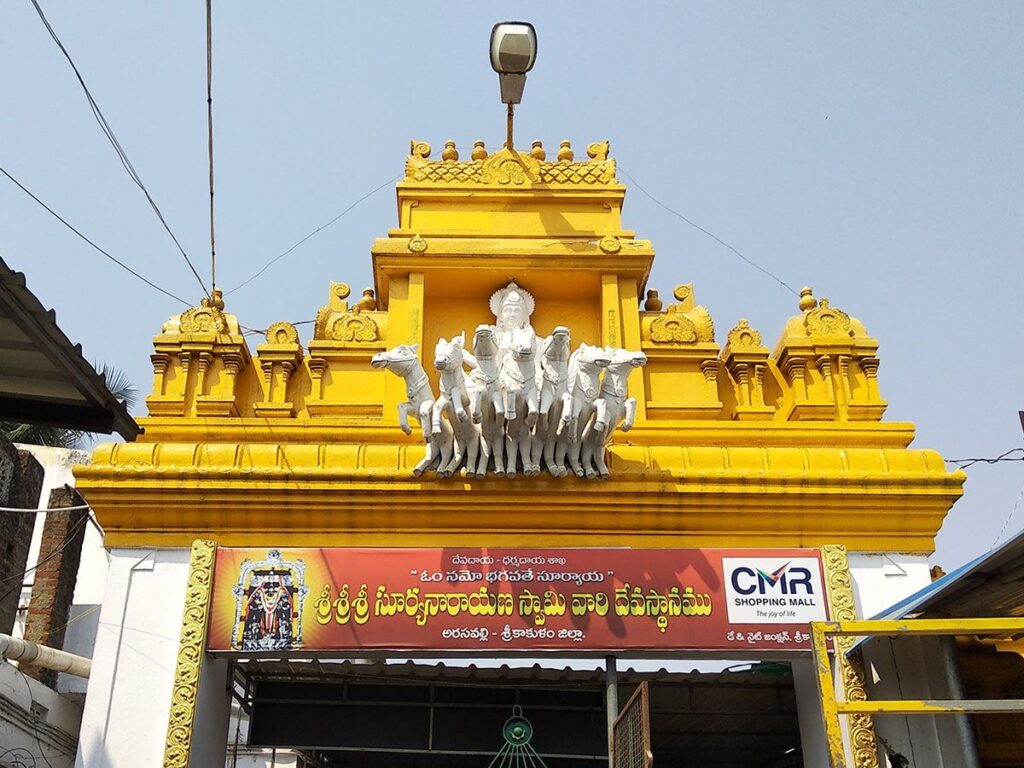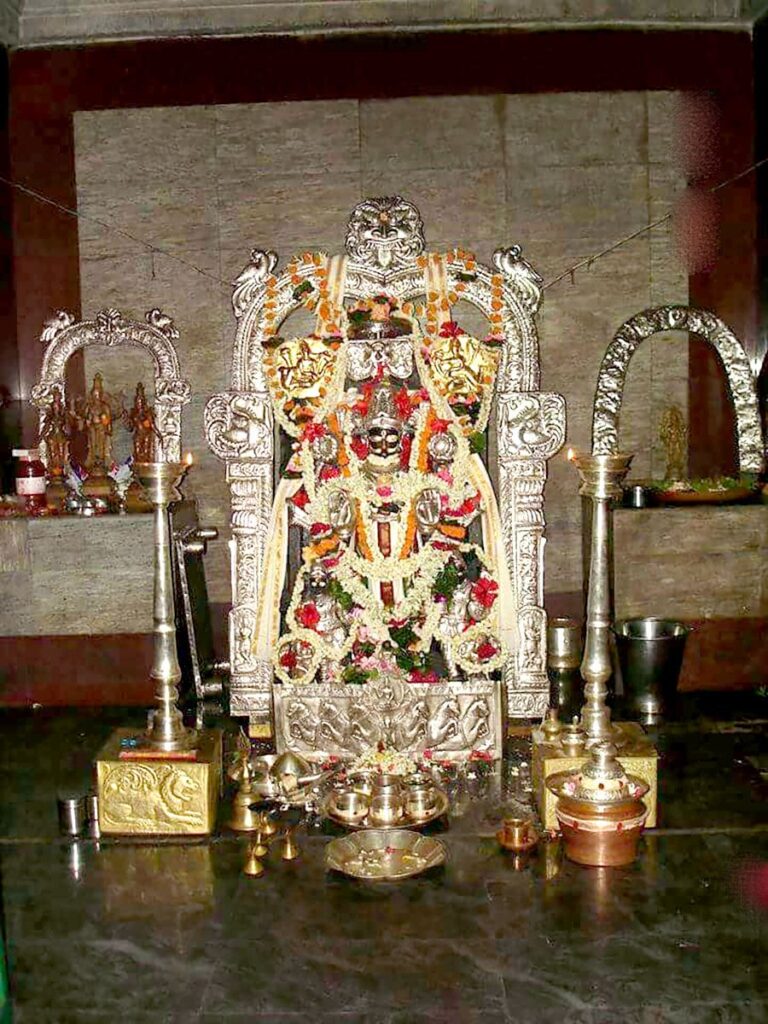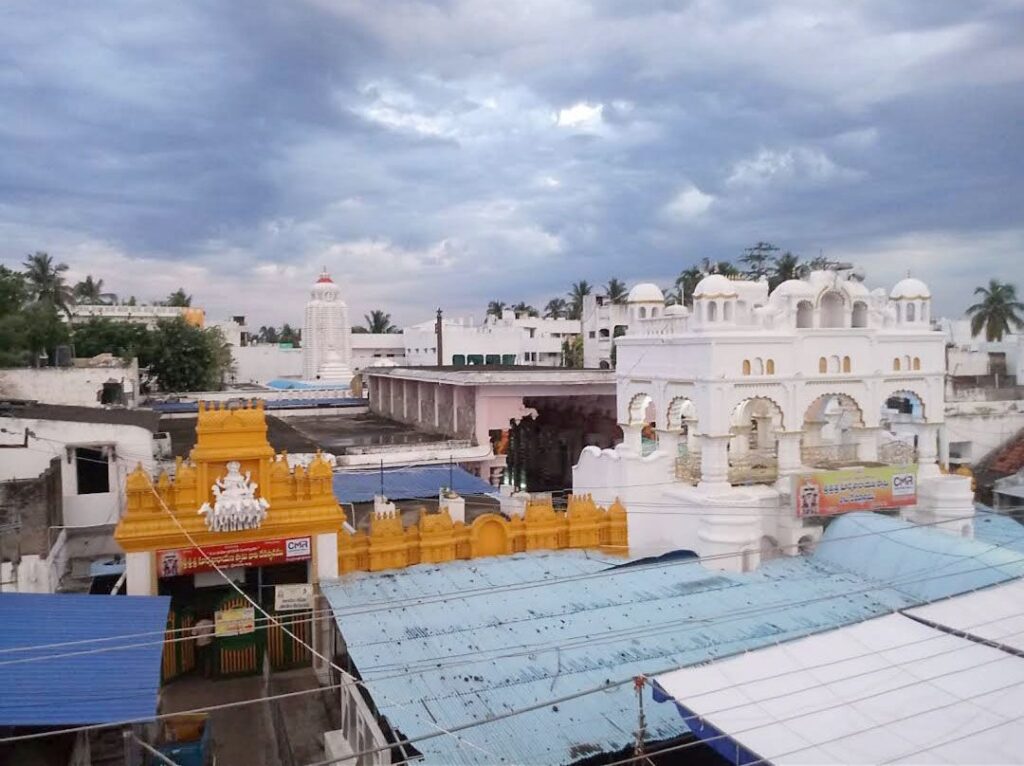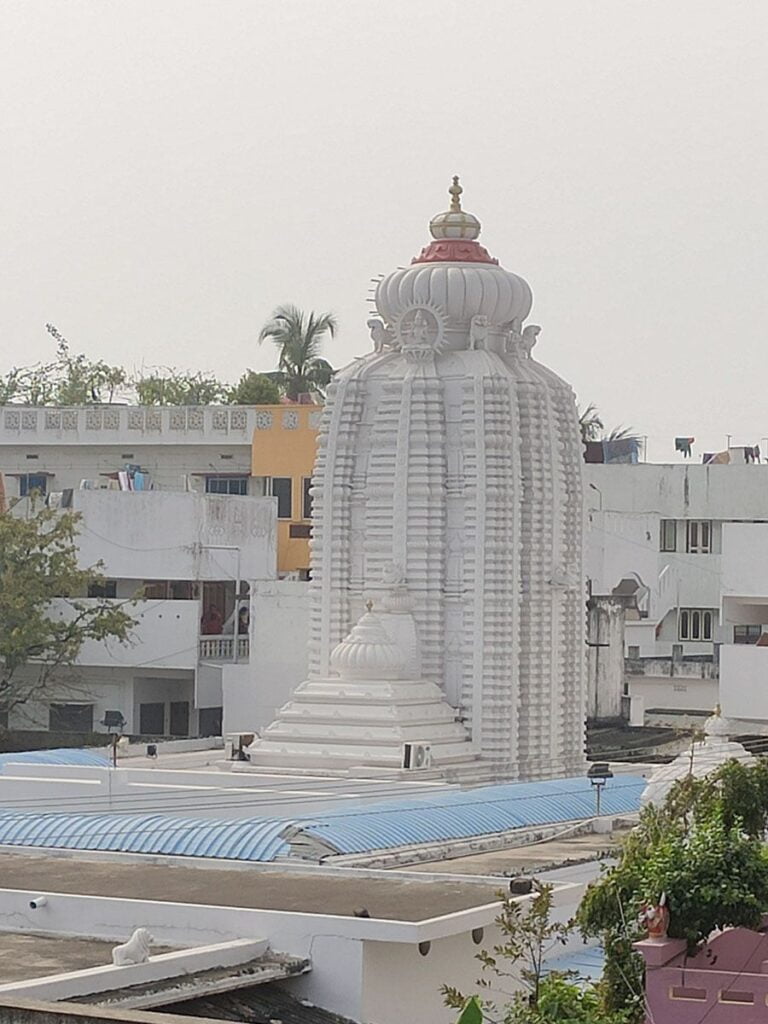Arasavalli Temple | Sri Suryanarayana Swamy Temple
The Arasavalli Temple is a Hindu temple dedicated to the sun god Surya/ Sri Suryanarayana Swamy, located in Arasavalli, a village in the Srikakulam district of the Indian state of Andhra Pradesh. It is one of the two major sun temples in India, the other being the Konark Sun Temple in Odisha. The temple was built in the 7th century CE by the Eastern Ganga dynasty, and is considered to be one of the finest examples of Kalinga architecture.

Contents
- 1 Arasavalli Temple History:
- 2 Legend of Arasavalli Temple:
- 3 Significance of Arasavalli Temple:
- 4 Myths of Arasavalli Temple:
- 5 Interesting facts about Arasavalli Temple:
- 6 Arasavalli Temple Timing and Rituals:
- 7 Places to visit near Arasavalli Temple:
- 8 FAQ:
- 8.0.1 1. What is the significance of Arasavalli Temple?
- 8.0.2 2. Where is Arasavalli Temple located?
- 8.0.3 3. What are the temple timings?
- 8.0.4 4. Are there any festivals celebrated at Arasavalli Temple?
- 8.0.5 5. Is there an entry fee to visit Arasavalli Temple?
- 8.0.6 6. Can non-Hindus visit Arasavalli Temple?
- 8.0.7 7. Are there any nearby attractions to visit along with Arasavalli Temple?
- 8.0.8 8. Is photography allowed inside the temple?
- 8.0.9 9. How can I participate in the temple rituals?
- 8.0.10 10. How do I reach Arasavalli Temple?
- 8.0.11 11. What is the architectural style of the temple?
- 9 How to reach Arasavalli Temple:
- 10 Google Maps:
Arasavalli Temple History:
Origins and Construction:
- Legends: Tales from the Padmapuranam ascribe the idol’s installation to Sage Kasyapa, while the temple’s founding is attributed to Lord Devendra.
- Historical Evidence: Stone inscriptions suggest King Devendra Varma of the Eastern Ganga Dynasty built the temple in the 7th century CE.
Architectural Evolution:
- Original Style: Built in the Rekha deula style of Kalinga architecture, similar to the Puri Jagannath temple.
- Renovations: The current structure mainly reflects 18th-century renovations that addressed structural flaws. The Dusi family contributed significantly to these changes.
Architectural Highlights:
- Sun’s Alignment: The temple is positioned so that the first rays of the sun on specific dates in February and June fall directly on the deity’s feet.
- Idol and Deities: The central idol depicts Lord Surya holding lotus flowers, riding a chariot, and crowned by the serpent Adisesha. Other shrines within the complex honor Shiva, Vishnu, Anjaneya, Kala Bhairava, Subramanya, and Goddess Mahalaxmi.
Read More>> Powerful Annavaram Temple Sri Veera Venkata Satyanarayana Swamy

Legend of Arasavalli Temple:
Mythological Legend:
- Padmapuranam: This ancient text narrates that Sage Kasyapa, seeking the Sun God’s blessings for humanity, installed his idol at Arasavalli. This Surya idol belonged to the “Kasyapasa Gotra” lineage and earned the title “Planetary King.”
- Indrapuskarini Lake: King Indra, impressed by Kasyapa’s devotion, used his thunderbolt (Vajrayudha) to create a holy pond – the Indrapushkarini. Devotees believe bathing in this pond before offering prayers enhances their blessings from Lord Surya.
Historical Legend:
- King Devendra Varma: Historical records point to King Devendra Varma, a 7th-century ruler of the Eastern Ganga Dynasty, as the temple’s founder. Inscriptions on the temple walls corroborate this claim.
- Renovations: While the initial construction dates back to the 7th century, the present structure primarily reflects 18th-century renovations undertaken by the Dusi family.
Read More>> Antarvedi Lakshmi Narasimha Swamy Temple
Significance of Arasavalli Temple:
Historically:
- Believed to be built in the 7th century CE, making it one of the oldest Sun temples in India.
- Constructed by King Devendra Varma of the Eastern Ganga Dynasty, highlighting its connection to Kalinga’s rich cultural heritage.
- The present structure primarily stands as a result of 18th-century renovations, offering a glimpse into architectural practices across different eras.
Architecturally:
- Exemplifies the Rekha Deula style of Kalinga architecture, sharing similarities with the Puri Jagannath temple.
- Recognized for its precision in aligning with the sun’s movement, allowing the first rays to fall on the deity’s feet twice a year, considered an architectural marvel.
- The presence of five deities (Panchayatana) representing different faiths demonstrates its inclusive nature and potential to unite people across beliefs.
Religiously:
- Dedicated to Lord Surya, who symbolizes vitality, health, and prosperity, attracting devotees seeking blessings in these areas.
- Home to the Indra Pushkarini, a holy lake believed to have been dug by the god Indra, making it a sacred space for devotees seeking purification and spiritual upliftment.
- Hosts the Ratha Saptami festival, celebrating the Sun God’s birthday and attracting large crowds, further emphasizing its religious importance.
Additionally:
- Serves as a cultural landmark, attracting tourists and fostering local traditions.
- Promotes unity in diversity by attracting people from different backgrounds and showcasing religious tolerance through its architecture and symbolism.
Read More>> 5th CE Yaganti Temple with Mysteries

Myths of Arasavalli Temple:
1. The Myth of Indra and the Sun God:
- The most well-known myth tells the story of Indra, the king of the gods. According to legend, Indra was once injured by the demon Nandi and fell unconscious. In his unconscious state, he dreamt that he would be cured of his injury if he built a temple dedicated to the Sun God Surya and installed an idol of him there.
- Upon waking, Indra remembered his dream and set out to find the perfect location for the temple. He eventually came upon Arasavalli, a place believed to be blessed by the Sun God. There, he found a beautiful idol of Surya with his three consorts, Usha, Chaya, and Padmini.
- Indra built the Arasavalli Sun Temple and installed the idol. As promised, he was cured of his injury. The temple is said to be a powerful place of healing, and many devotees visit it seeking blessings for good health.
2. The Myth of the Self-Manifesting Idol:
- Another myth suggests that the idol of Surya at the Arasavalli temple was not created by human hands but manifested itself miraculously. According to this legend, a group of priests were performing penance at Arasavalli when the idol of Surya suddenly appeared before them.
- This myth adds to the temple’s sacredness and reinforces the belief that it is a special place chosen by the Sun God himself.
3. The Myth of the Moving Shadow:
- An interesting myth associated with the temple is the myth of the moving shadow. The temple is designed in such a way that the shadow of the chariot of the Sun God falls directly on the feet of the idol inside the sanctum sanctorum during the equinoxes.
- This phenomenon is seen as a miraculous sign of the Sun God’s presence and is a major draw for devotees during the equinoxes.
4. The Myth of the Underground Passage:
- There is a legend that there is an underground passage leading from the Arasavalli Sun Temple to another Sun Temple located in Konark, Odisha. This passage is said to be used by the Sun God to travel between the two temples.
- While there is no historical evidence to support this myth, it adds to the mystique of the temple and fuels the imaginations of visitors.
Read More>> Raghavendra Swamy Temple Mantralayam

Interesting facts about Arasavalli Temple:
Architectural marvel:
- Solar alignment: Twice a year, the first rays of the sun fall directly on the deity’s feet, even with closed doors – a testament to precise ancient planning. This occurs during Uttarayana (Mar 9-11) and Dakshinayana (Oct 1-3).
- Rekha deula style: Built in the 7th century, the temple’s towering structure exemplifies the Kalinga architectural style, similar to the Puri Jagannath temple.
- Sculptural prowess: Intricate carvings adorn the temple walls, depicting deities, celestial bodies, and mythological scenes.
Historical significance:
- One of the oldest Sun temples: The temple finds mention in ancient texts like the Padmapuranam, making it one of the earliest dedicated to Surya.
- Royal patronage: Believed to be built by King Devendra Varma of the Eastern Ganga Dynasty, the temple witnessed renovations and patronage by various rulers throughout history.
- Mythological associations: Legend says Sage Kasyapa installed the Surya idol for humanity’s well-being, while another story credits Lord Indra with finding the existing idol.
Cultural importance:
- Ratha Saptami festival: This grand festival celebrates Surya’s birthday and attracts thousands of devotees, making it the temple’s most significant event.
- Healing powers: Devotees visit the temple seeking blessings for eye and skin ailments, believing in the Surya’s healing energy.
- Unique location: Situated on the east coast, the temple holds significance for coastal communities who revere the sun for its life-giving properties.
Read More>> Vijayawada Kanaka Durga Temple: A Beacon of Hope & Strength

Arasavalli Temple Timing and Rituals:
General Timings:
- Morning: 6:00 AM to 12:30 PM
- Evening: 3:30 PM to 8:00 PM
Specific Rituals:
- Nijaroopa Darshan: This allows devotees to view the idol without any coverings. It happens daily from 6:00 AM to 4:00 PM.
- Suryanamaskaram: Surya Namaskarams, or sun salutations, are performed daily from 6:00 AM to 12:00 PM. The temple facilitates this practice.
- Special Rituals during Festivals: During festivals like Ratha Saptami, the temple opens earlier and special rituals like Visesha Archana Neerajanam, Mantrapushpam, and Balabhoga Nivedana are performed at 7:00 AM.
Festivals:
The major festivals celebrated at the temple include:
- Ratha Saptami, which is celebrated in the month of Magha (January-February).
- Surya Jayanthi, which is the birthday of the Sun God, is celebrated in the month of Chaitra (March-April).
- Ugadi, the Telugu New Year, is also celebrated with great pomp and show at the temple.
Read More>> Tirumala Tirupati Venkateswara Swamy
Places to visit near Arasavalli Temple:
- Srikurmam:
- Located around 15 kilometers from Arasavalli, Srikurmam is known for the Kurmavatar Temple dedicated to Lord Vishnu in his tortoise incarnation.
- Srikakulam:
- The district headquarters, Srikakulam, offers historical and cultural attractions, including the Srikakulam Fort, Kalinga Maharaja Fort, and the beautiful Srikakulam Beach.
- Kalingapatnam:
- Situated along the Vamsadhara River, Kalingapatnam is known for its historical significance. Visit the Kalingapatnam Beach and the old lighthouse for a scenic experience.
- Salihundam:
- Around 20 kilometers from Arasavalli, Salihundam is an archaeological site with ancient Buddhist stupas and monastic ruins, providing insights into the region’s history.
- Baruva Beach:
- Located about 60 kilometers from Arasavalli, Baruva Beach is a serene coastal spot where the river meets the Bay of Bengal. It’s known for its scenic beauty and tranquility.
- Mukhalingam:
- Mukhalingam, approximately 50 kilometers away, boasts the Mukhalingeswara Swamy Temple, known for its architectural beauty and historical significance.
- Palasa:
- Palasa, around 40 kilometers from Arasavalli, is known for the Suryanarayana Temple and the unique Harishchandra Mahal, reflecting architectural finesse.
- Rama Sagar Reservoir:
- If you enjoy natural landscapes, visit the Rama Sagar Reservoir, located around 30 kilometers from Arasavalli. It’s a picturesque spot surrounded by hills.
FAQ:
1. What is the significance of Arasavalli Temple?
- Arasavalli Temple is dedicated to Lord Suryanarayana, the Sun God, and holds immense religious and cultural significance. It is one of the ancient and revered temples in the region.
2. Where is Arasavalli Temple located?
- Arasavalli Temple is situated in the town of Srikakulam in Andhra Pradesh, India. The exact address is [provide the address].
3. What are the temple timings?
- The temple typically opens in the morning and closes in the evening. Please check the current timings, as they may vary on special occasions or festivals.
4. Are there any festivals celebrated at Arasavalli Temple?
- Yes, Arasavalli Temple celebrates various festivals, including the annual Rath Yatra and Surya Jayanti. The temple is adorned with decorations and witnesses a surge in devotees during these celebrations.
5. Is there an entry fee to visit Arasavalli Temple?
- Generally, there is no entry fee to visit the temple. However, donations are welcome for the maintenance and upkeep of the temple premises.
6. Can non-Hindus visit Arasavalli Temple?
- Arasavalli Temple welcomes visitors of all faiths. However, it is important to respect and adhere to the religious practices and customs followed in the temple.
7. Are there any nearby attractions to visit along with Arasavalli Temple?
- Yes, there are several nearby attractions, such as [list a few attractions], making it an ideal location for a spiritual and cultural exploration.
8. Is photography allowed inside the temple?
- Photography rules may vary, so it is advisable to check with the temple authorities. In some temples, photography may be restricted in certain areas or during specific rituals.
9. How can I participate in the temple rituals?
- Devotees are welcome to participate in various rituals. It is recommended to check the schedule and guidelines provided by the temple authorities for specific rituals and ceremonies.
10. How do I reach Arasavalli Temple?
- Depending on your location, you can reach Arasavalli Temple by [mentioning modes of transportation, such as car, bus, or train]. Ensure you have the latest information on transportation options and routes.
11. What is the architectural style of the temple?
- The Arasavalli Sun Temple is known for its unique Dravidian style of architecture. The temple has a towering gopuram (temple tower), intricate carvings, majestic pillars, and a sanctum sanctorum where the deity of Sun God stands on a chariot driven by seven horses.
How to reach Arasavalli Temple:
- By Air:
- The nearest airport is Visakhapatnam International Airport (VTZ), which is approximately 115 kilometers away from Arasavalli. From the airport, you can hire a taxi or use other local transportation to reach the temple.
- By Train:
- The nearest major railway station is Srikakulam Road Railway Station, which is well-connected to various cities in India. From the railway station, you can hire a taxi or use local transportation to reach Arasavalli.
- By Bus:
- Arasavalli is accessible by road, and there are regular bus services from nearby towns and cities. You can check with the local bus station for information on buses heading to Arasavalli.

2 Comments